Search for:
ASIAN
CANADIANS
> Museums
Fish Skin Clothing
Talk presented at the Textile Museum of Canada (2007)
All photographs by Ruth Lor Malloy
Copyright © 2008 by Ruth
Lor Malloy. All rights reserved
How did I get involved in fish
skin clothing? It started in Beijing, China, where a museum curator
told me that a Hezhen woman still made traditional fish-skin
clothing in Heilongjiang province. This is where the Hezhen language
originated from probably a couple of thousand years ago. Today,
the Hezhen people live in the eastern part of Asia in China and
Siberia.
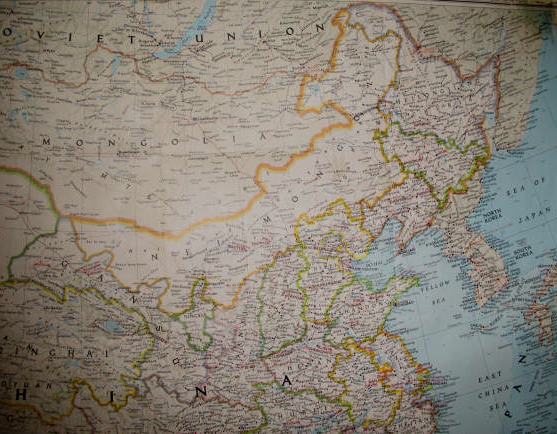
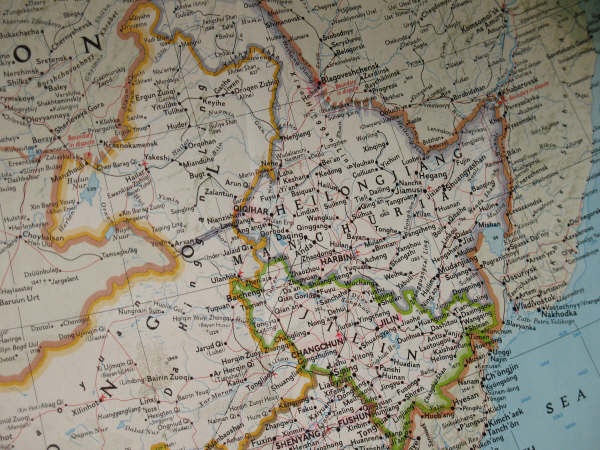
Heilongjiang - Harbin - Jiamusi - Tongjiang. This is the area
where our suit comes from, specifically from the Hezhen village
of Jiejinkou. You can see how close this area is to Siberia.
It takes at least a
month to make a suit of fish skin clothing. In spite of the risk
of ordering something sight unseen, I took the chance, ordered
two sets of clothing, paid in advance as required, and booked
a trip there to pick them up. I don't know what I would have
done if both museums had said the results weren't good enough
and they didn't want them. I would have been out several thousands
of dollars.
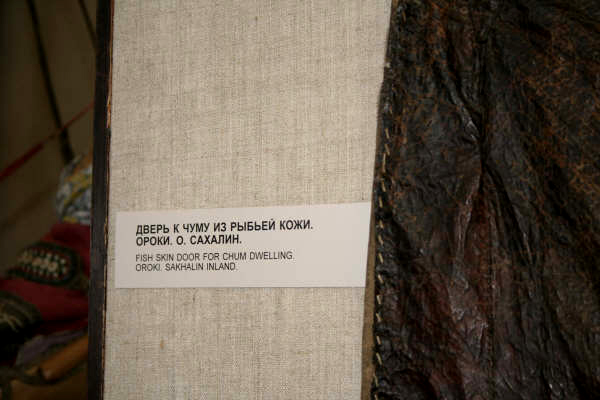
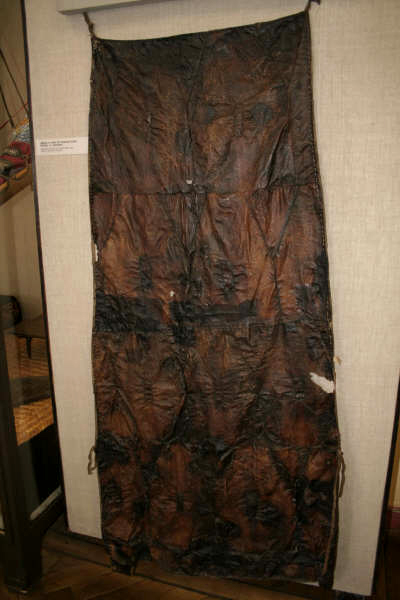
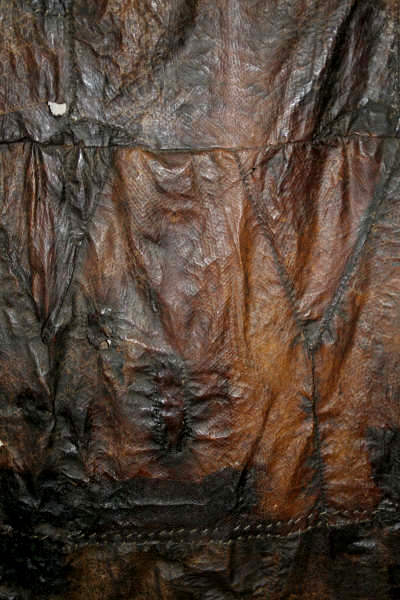
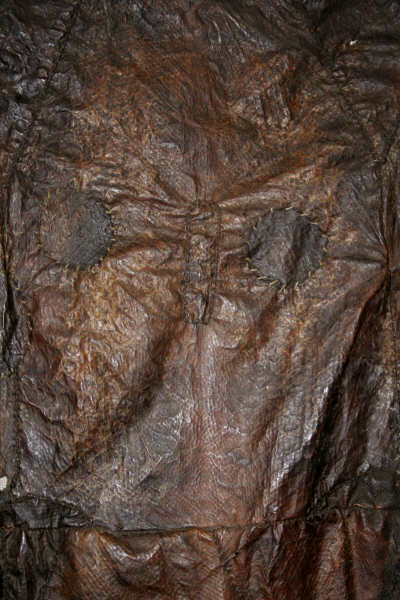 On the way to China,
I stopped in St. Petersburg, Russia, where in the Museum of Ethnology
we found an old fish-skin door cover from Sakhalin Island in
Siberia. It looked patched with what is probably cotton thread,
but you can see the darker, older traditional thread - probably
animal sinew.
The Russians have been
doing ethnic cultural research and collecting since Peter the
Great in the 18th century. This museum is one of the best in
the world. They are a long way ahead of China in this regard.
This fish-skin fabric, if you can call it fabric, is supposed
to be waterproof. And you can expect that our clothes might turn
this dark some day too.
On the way to China,
I stopped in St. Petersburg, Russia, where in the Museum of Ethnology
we found an old fish-skin door cover from Sakhalin Island in
Siberia. It looked patched with what is probably cotton thread,
but you can see the darker, older traditional thread - probably
animal sinew.
The Russians have been
doing ethnic cultural research and collecting since Peter the
Great in the 18th century. This museum is one of the best in
the world. They are a long way ahead of China in this regard.
This fish-skin fabric, if you can call it fabric, is supposed
to be waterproof. And you can expect that our clothes might turn
this dark some day too.
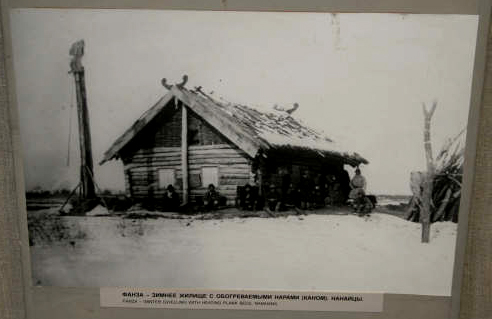
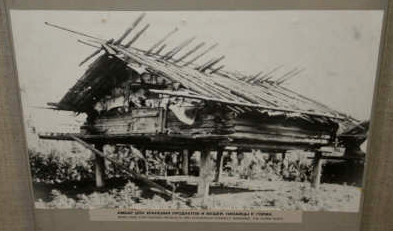 The Russian museum
had a photo of a Nanai Cottage. The Nanai and the Hezhen are
the same people, with different names in Russia and in China.
Take a good look at this Nanai cottage. You will see a similar
style later in northeast China in a Hezhen village.
The Russian museum
had a photo of a Nanai Cottage. The Nanai and the Hezhen are
the same people, with different names in Russia and in China.
Take a good look at this Nanai cottage. You will see a similar
style later in northeast China in a Hezhen village.
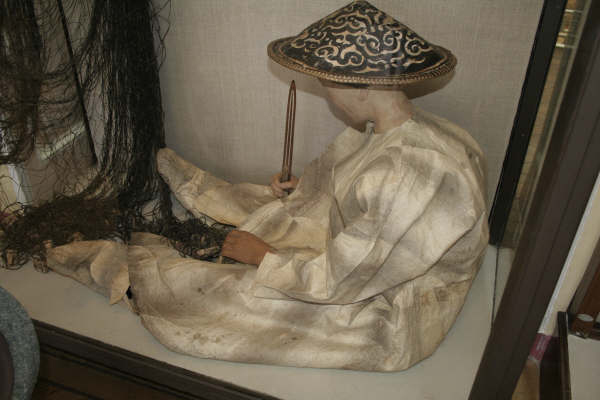
You can guess that this Nanai fish skin garment is recent because
it is much lighter in colour. You've probably noticed that the
Chinese fish skin garments are more fitted, more influenced by
19th and 20th century Chinese styles. This one has probably been
influenced more by Russian styles, by other ethnic groups in
that country.
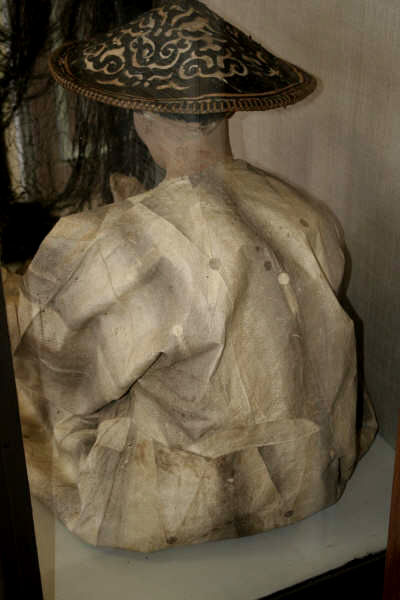
19. The back side looks patched. The birch bark hat is also typical
of people living in China. A mention of people wearing fish skin
can be found in 2,000-year-old Chinese records.
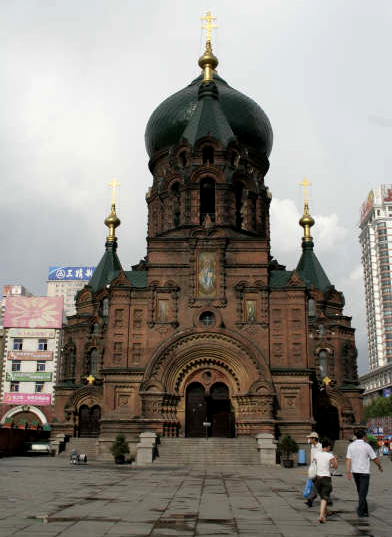
I went through Harbin in China. This is a city that was home
to Russian garrisons and over 20 other foreign nationalities
in the early 1900s. The Russians built a railway here. Harbin
is the capital of Heilongjiang province. This Russian Orthodox
Church still stands there, a museum of that period.
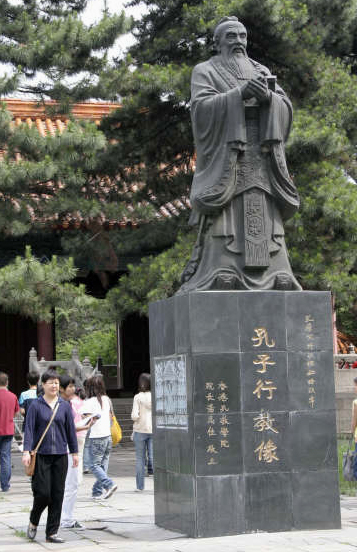
Harbin also has a Confucian Temple that now houses the province's
ethnic museum.
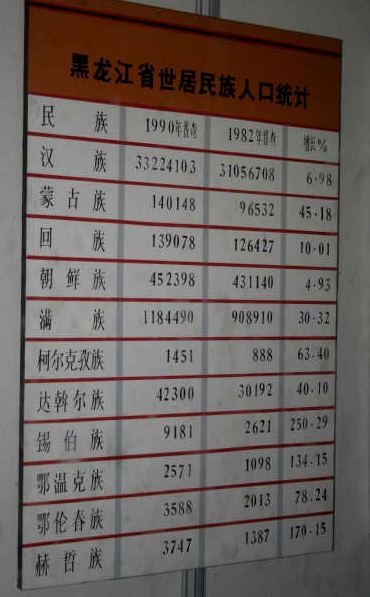
Statistics on display are of minority populations in Heilongjiang.
Here you can see that they have been growing from 1982 to 1990.
The Hezhen people were badly abused during the Japanese occupation
of China. When the Japanese left, only about 300 remained. The
census of the year 2000 counted 4,640 individuals - not a large
base to maintain a culture.
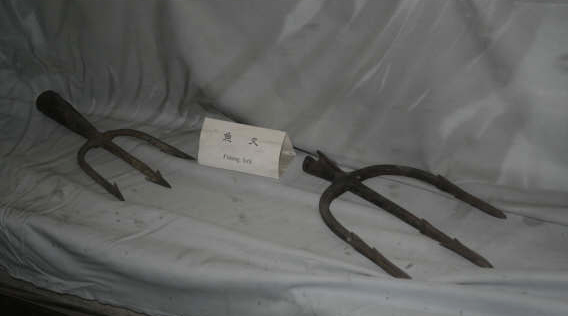
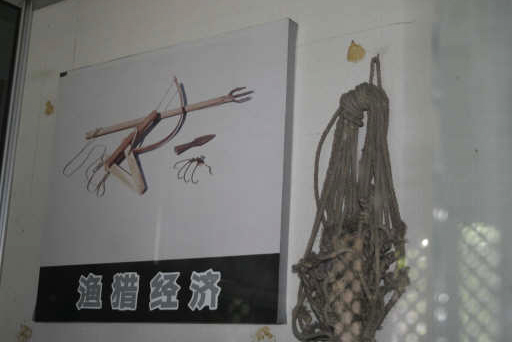 The museum displays
some of their fishing gear. Ms. You Wenfeng said she used to
spear fish as a child. Today, she prefers to make clothes with
fish caught by net so their skins are not damaged.
The museum displays
some of their fishing gear. Ms. You Wenfeng said she used to
spear fish as a child. Today, she prefers to make clothes with
fish caught by net so their skins are not damaged.
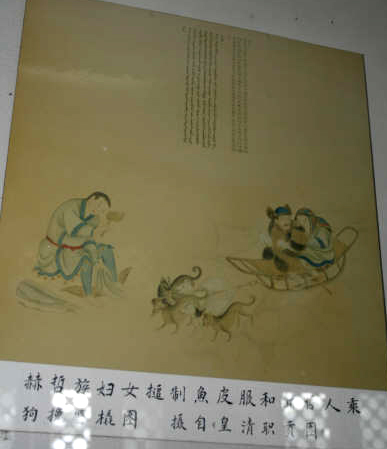 The museum had on exhibit
some old style paintings that looked much too idyllic to be true.
Ms. You said the men wore fish skin in summer and hides in the
winter. It's true that in the old days, the Hezhen people used
dog sleds but these tiny guys look too scrawny to have the strength
to pull a sled with two men. The men here are probably wearing
deer fur, which is traditional, but I wonder if the artists actually
saw any Hezhen people. Each family used to have as many as ten
dogs but they no longer use dogs for work.
The museum had on exhibit
some old style paintings that looked much too idyllic to be true.
Ms. You said the men wore fish skin in summer and hides in the
winter. It's true that in the old days, the Hezhen people used
dog sleds but these tiny guys look too scrawny to have the strength
to pull a sled with two men. The men here are probably wearing
deer fur, which is traditional, but I wonder if the artists actually
saw any Hezhen people. Each family used to have as many as ten
dogs but they no longer use dogs for work.
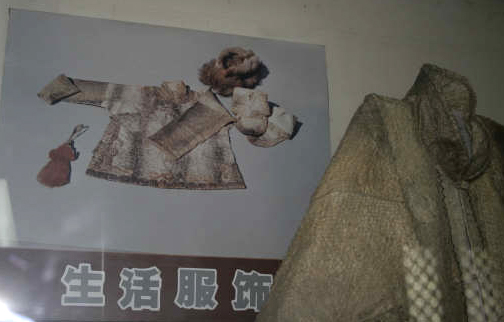
Woman's jackets were opened on the side, like they are today.
They decorated their clothes with appliqués of stylized
clouds, animals, flowers and good luck or religious symbols.
Buttons were cloth, fish skin or fish bone. The man's jacket,
which looks like fish skin, is open in front. Mrs. You said both
men and women wore trousers.
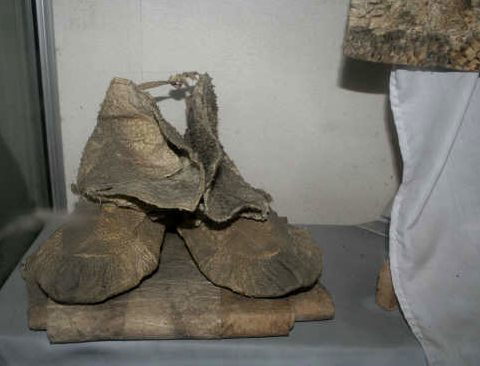
The museum has some old shoes, similar to the pair we have here.
You might notice the similarity to the moccasin - flat on the
top of the foot, and gathered to fit the foot. The Bata museum
has loaned some of its fish skin boots to augment our exhibit.
They are from Siberia and much fancier.

We took a train about 400 kilometres northeast from Harbin to
Jiamusi, which is at the northern end of a superhighway that
runs from the Heilongjiang River and the border all the way to
the south of China. This statue marks the beginning of this highway,
another factor that will probably destroy the Hezhen culture.

The nearby Heilongjiang River has lots of room for big fish to
grow. It is called the Amur River in Siberia.

The local Jiamusi museum.
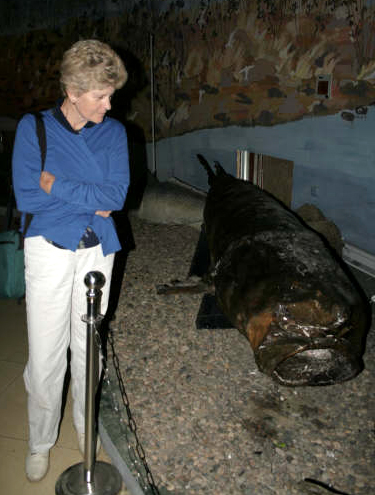
My travel companion, Joan Ahrens, inspects one of the big fish.
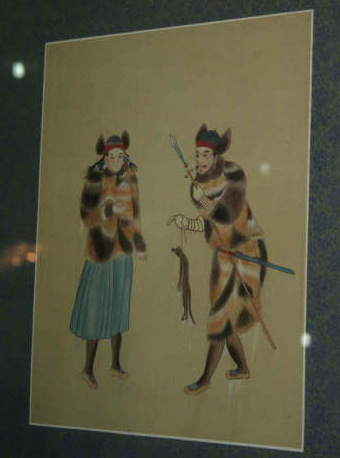
Another old idyllic painting.
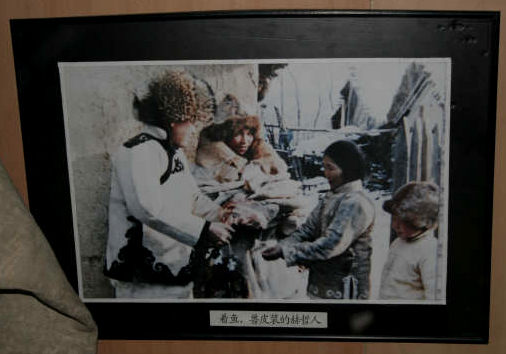
This looks like this woman in costume is receiving help. It's
hard to image that these are among the people that the Great
Wall was meant to keep out.
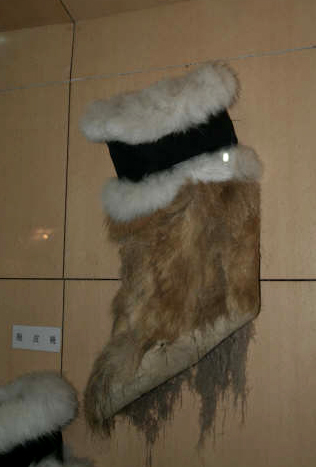
Here is a fur boot, trimmed with black fur, and probably of deer
skin. In the winter, the Hezhen wore deer skin.
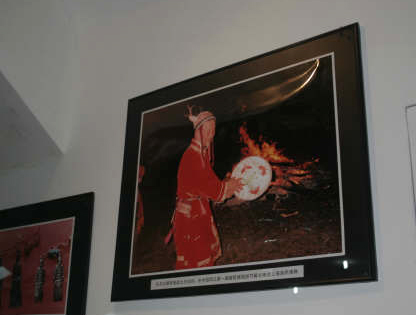
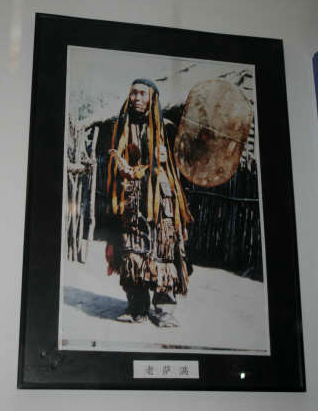
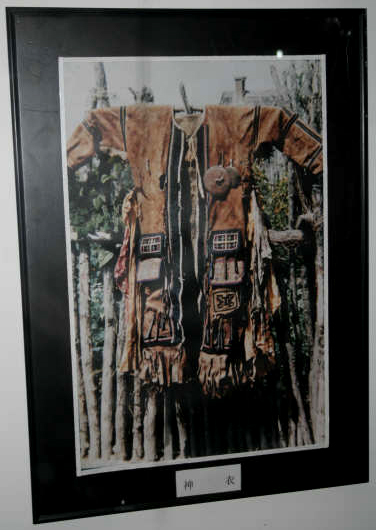
Like many of the other people in this northeast region in the
old days, the Hezhen people relied on shamans instead of doctors.
Ms. You said her own religion was shamanistic.
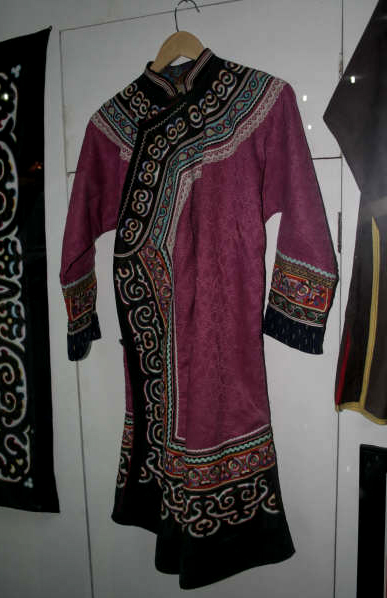
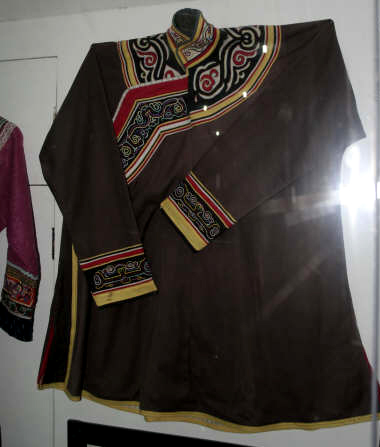
Generally, they stopped wearing fish skin generally after the
Communist government took over China in 1949. Those who could
afford it, started using silk and synthetics in old Chinese styles
earlier. With the end to civil war and the Japanese invasion,
the government started a program to help raise the living standards
of its ethnic minorities, many of whom live in border areas.
They needed these people to help secure their borders.
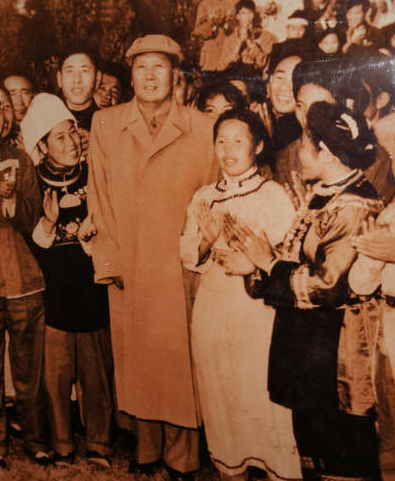

Government leaders visited the area. While most of China had
a one-child family planning policy, minorities like the Hezhen
were encouraged to have more than one child. The government opened
minority universities to encourage the 55 different documented
minority cultures to improve their self image and their economic
condition.
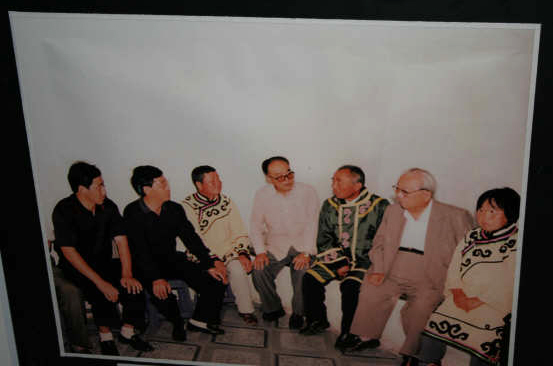
I love this picture of Hezhen people meeting government officials.
The woman is obviously shy and feeling uncomfortable with the
visiting dignitaries. In the past, the governments and most Chinese
people, the Han majority, looked down on the minorities as uncivilised
barbarians. No one bothered to do any research.

Things have changed for the better. The young people go to university
and get jobs in the big cities, their unique traditional cultures
lost or diluted. But the minority universities are doing research
into ethnic cultures and collecting costumes. There is some hope
that these traditions will not be completely lost.
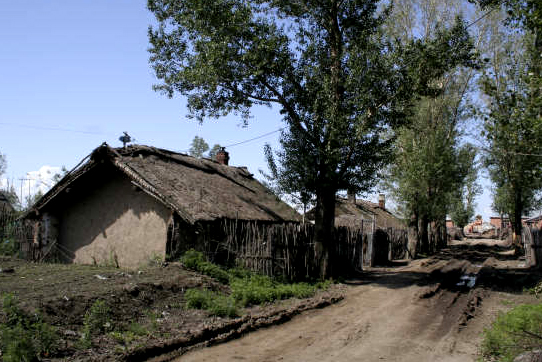
From Jiamusi, it is a three-hour drive to Tongjiang County, one
of the three counties where the Hezhens live. Then it is a 35-minute
drive to Jie Jin Kou, one of several Hezhen villages in the region.
The people who stay in the remote villages, and this is a very
remote village, are still struggling. Remember that house I showed
you from the museum in St. Petersburg? This one is almost the
same.
It looks like about
one-third of the houses in this tiny village are still like this,
made of tamped earth. The Hezhen do not have a written language
of their own. The average income I would guess is about USD 100
US a year - except for Ms. You.

Unlike the shy lady in the picture with the visiting dignitaries,
Ms. You Wenfeng, who made our suit of fish skin clothing, is
a real go-getter. She is not the least bit shy. Like the rest
of her family, she fished for a living. This is the village hall.
Ms. You was born in this village and has spent her life here,
receiving only a primary school education. Her family of eight
siblings was poor and she had to fish and take care of younger
brothers when she was small.
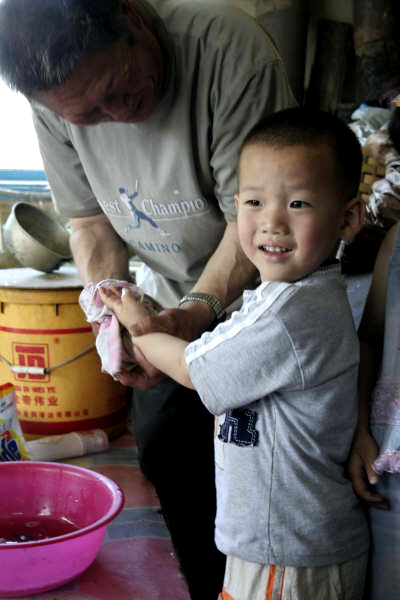
Her husband shown here helping dress their grandson is not of
the Hezhen nationality. There is a lot of intermarriage. But
he helps her with her project. She says there are four women
in this village who know how to make fish-skin clothing but she
is the best.
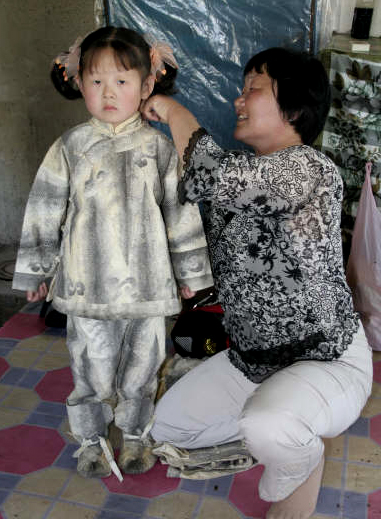
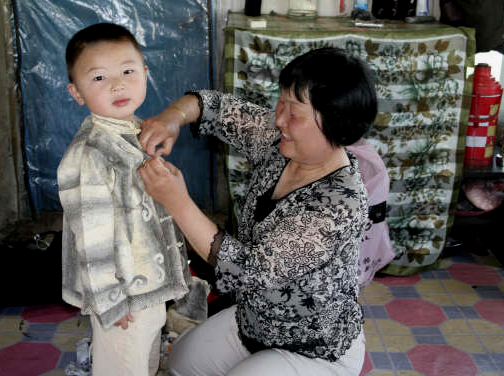
Her grandmother taught her how to make the clothes when a museum
in Beijing ordered a set. She was 21. She is now in her fifties.
Since then, she has made about 15 suits for museums in Japan
and China. She is teaching her daughter-in-law how to make them
as well but I don't think the art will last beyond this century.
No one is going to wear fish skin. It's very expensive and the
museums won't need any more.
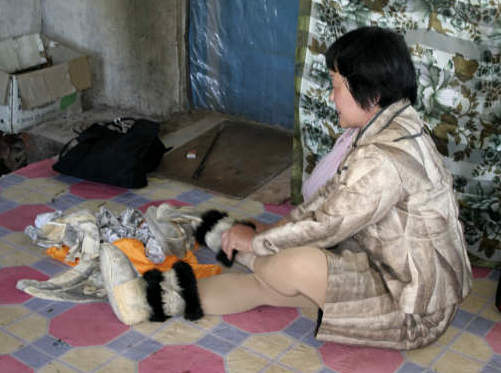
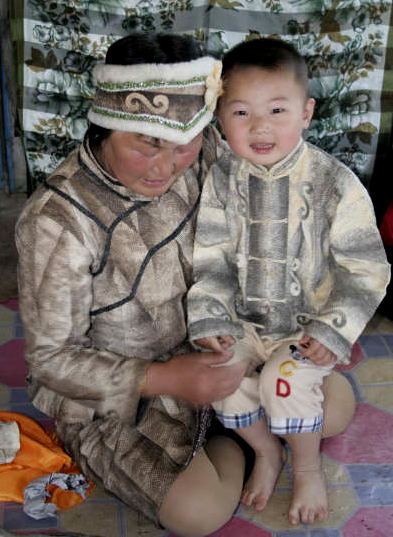
If you notice her boots, they are almost the same style as in
the museum, though not the same material. Ms. You said her fur-trimmed
boots took eight pieces of fish or forty kilograms to make. Ms.
You utilizes different kinds of fish for the shoes, thread, jackets,
trousers and trim. In the past, the Hezhen have used yellow croaker,
pike, carp, 'big head' and salmon. They made mittens out of salmon,
and leggings and bags out of huaitou fish. Our clothes are of
salmon.
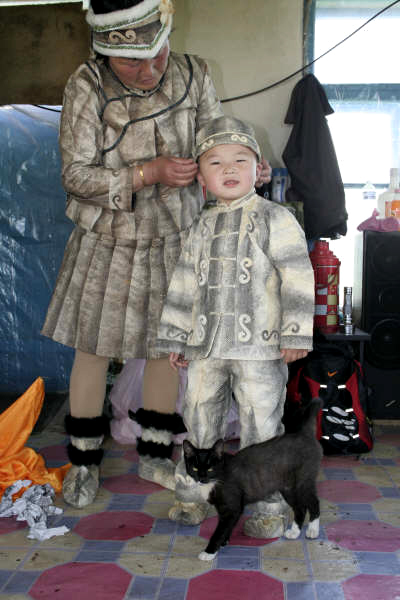
This is my favourite picture - because of the cat. Ms. You said
her own clothes of fish skin were chemically treated by a factory
so they wouldn't darken too much. But the clothing she makes
for museums are not treated. She also said the smell will go
away in a couple of months, but there's still an odour of fish
- and you can understand why such clothes are not worn very often
any more.
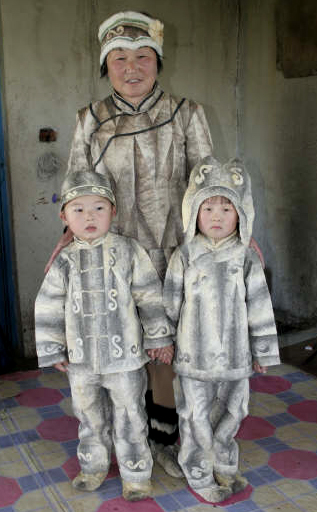
The children are cousins. I think it's sad that this might be
the only time in their lives that they will be wearing their
traditional clothing, unless Ms. You gets the children to dance
with her.
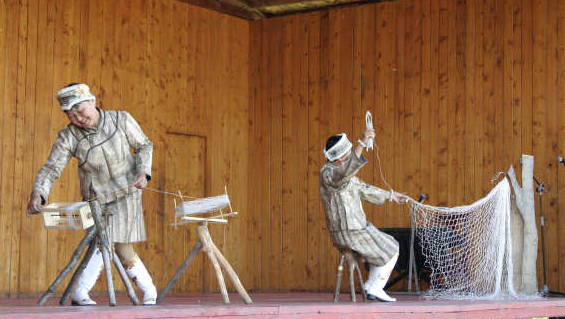
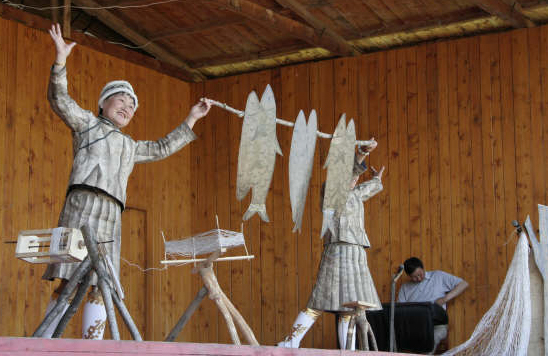
Ms. You interrupted our photo shoot to dance for the tourists
who visit her village. There are enough tourists who visit for
her to do this and for other young people in the village to dress
up to entertain in Chinese-style costumes.
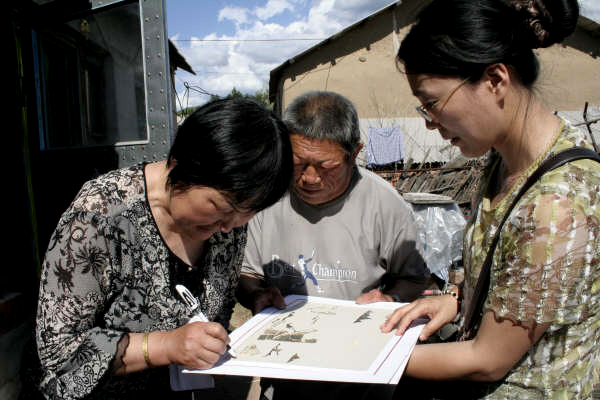


I can't see her doing this for free because she charged me an
additional USD100 just to sign a photo release. We negotiated
the price down to USD40. Ms. You's own suit with its modern mini-skirt
was treated with chemicals, but ours, in keeping to the original
technology, has not been so treated. I don't think we have to
worry about her being impoverished. She has also built her own
museum and was going to charge us a lot of money to take pictures
there. We visited her home as well. She is obviously not rich
in spite of the expensive prices she charges. Her own house was
not made of mud, but it was modest, two bedrooms, one of which
she shares with her son and daughter-in-law. She owns a nice
large television set, but that's the only luxury. They do have
electricity and they sleep on a traditional kang, a bed heated
in winter from below.
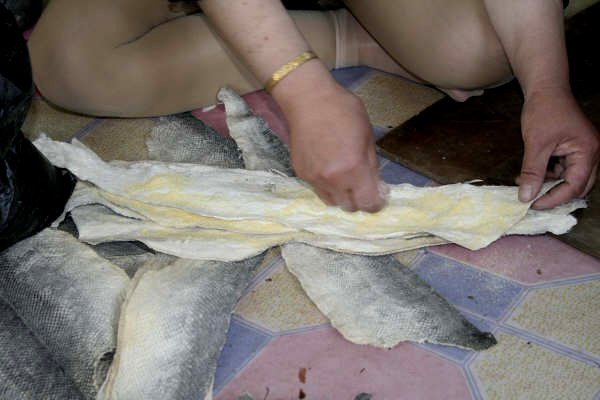
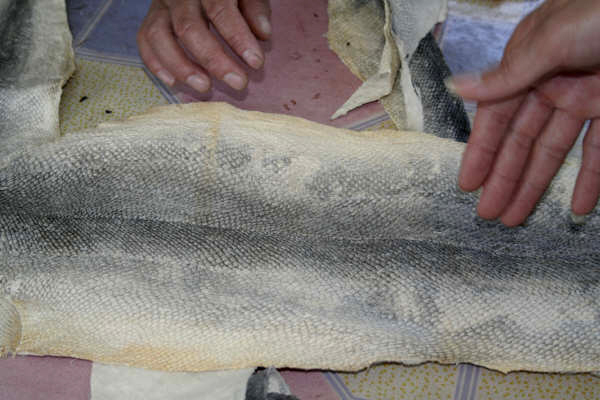
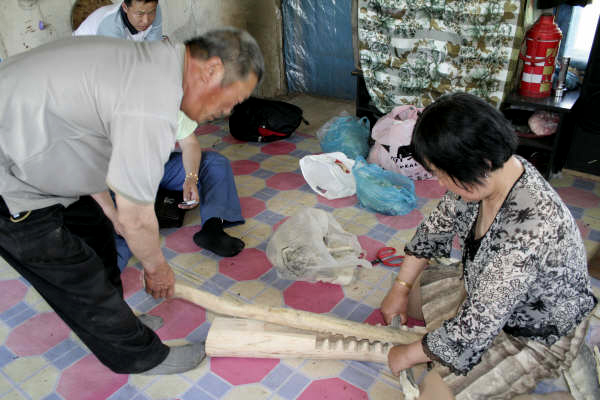
When processing the fish, she separates the flesh and the skins.
Then she and her husband cut off the fins, and try to leave fin
holes as small as possible. They scrape off any remaining bits
with a birch or bamboo knife. Ms. You plasters the skins onto
an earthen wall to dry. They will dry in one day if the weather
is sunny. Then she makes sure the lines of the skins are straight.
They put several skins into layers separated with corn or glutinous
millet flour to soak up the fish oil. They prefer fish that weigh
four to seven kilograms each.
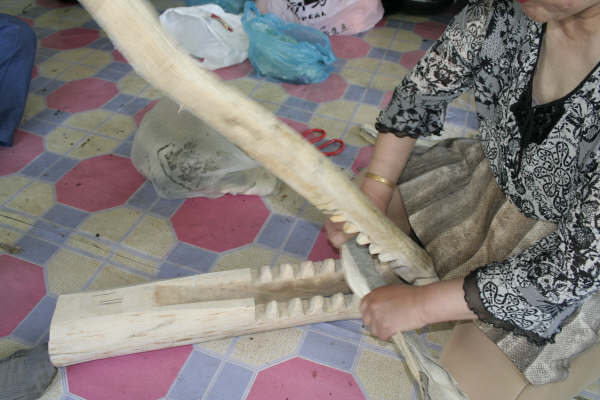
She will roll them into a cylinder and mash and soften them in
a large wooden scissor-like instrument called a mu he in Chinese
or a ge ji kou in the Hezhe language.
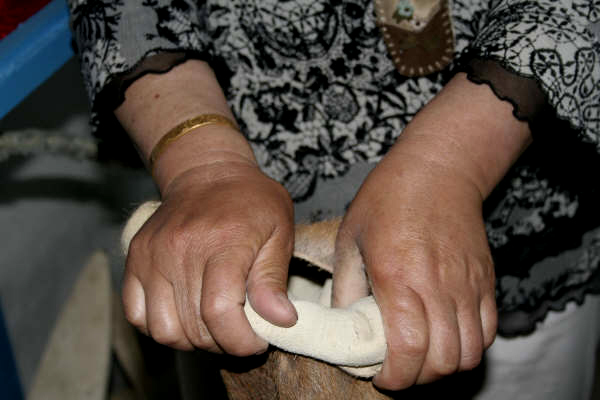
She also softens the skins by rubbing pieces of skin against
each other. After that, they trim them, scrape any remaining
fibre and scales away, and patch the holes from the fins with
matching colored skins. She will also twist them, and knead them…

… and then scrape away what is left of the scales.
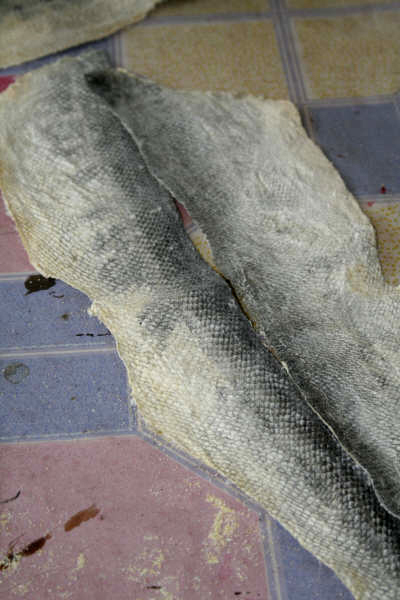
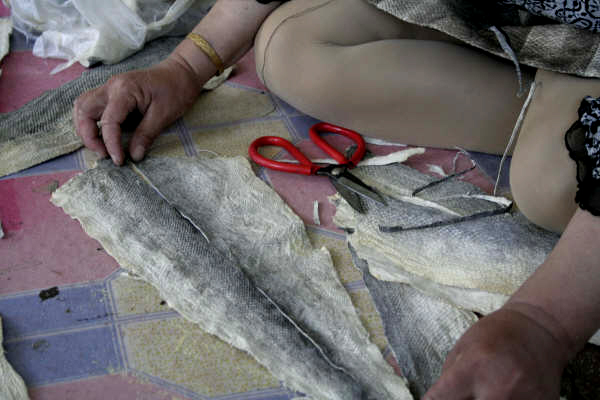
She will try to match the patterns together and…
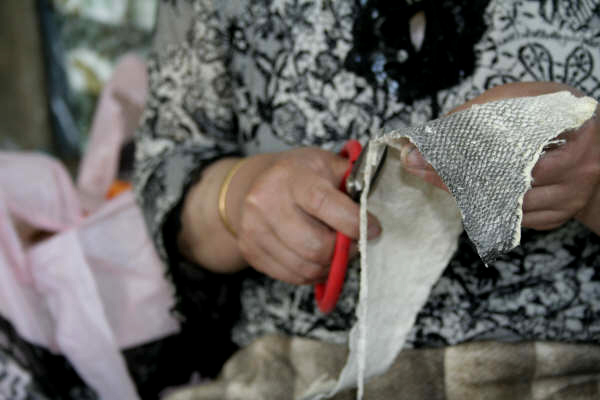
… using a similar pattern, she fills in the fin holes with
patches.
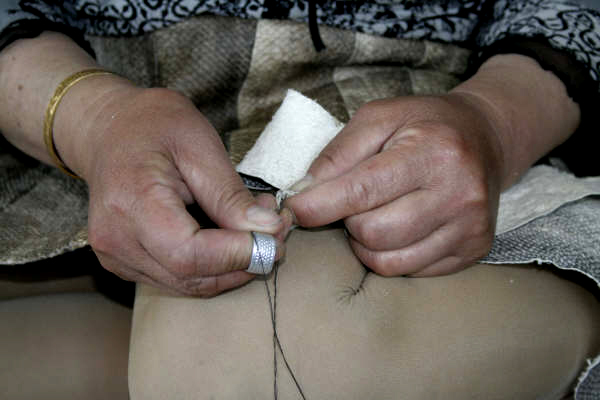
She does not use a pattern, it is done free hand. Here she uses
cotton thread, but in the old days, she says she used deer sinew.
It took her 20 days to make a set of children's clothing. Such
clothing will last ten years of use and shoes only two, she says.
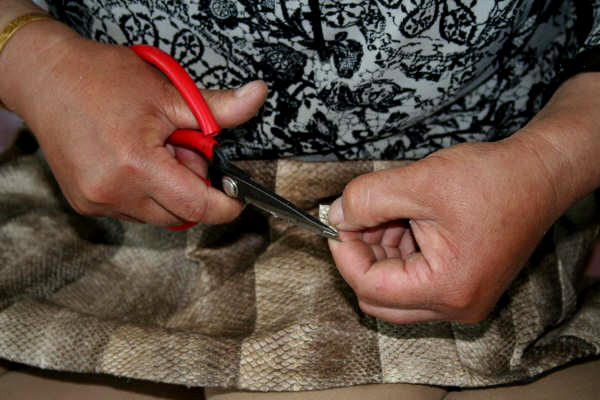
She glues on the appliqués, the traditional symbols of
good luck. She reinforces them with stitching. Ms. You says an
adult jacket and pants requires thirty pieces of skin. The decorations
are of traditional Hezhen designs and are attached first with
glue from the bladder of the yellow croaker and then sewn. The
S shape is a cloud.
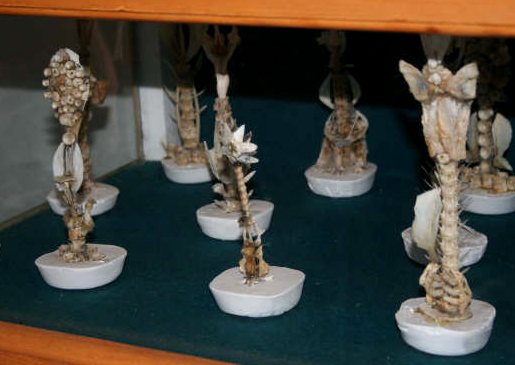
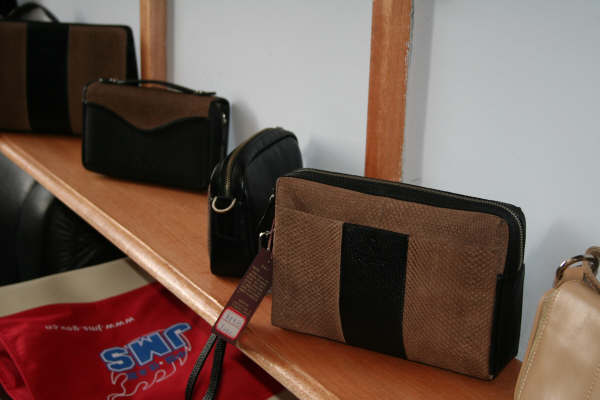
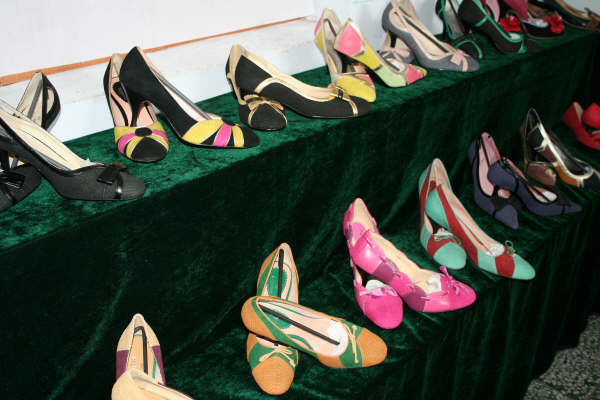
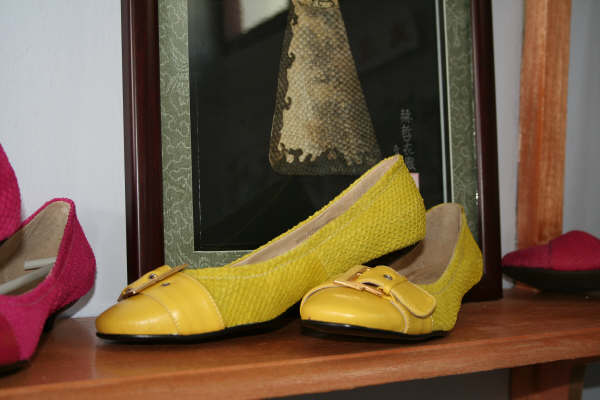
The local museum has a store where they sell fish skin souvenirs.
They also have some decent-looking fish skin hand bags, and some
decent looking shoes. The shoes and the bags are made in Guangdong
province in the south but with fish skin from Heilongjiang. They
were beyond my budget, so I didn't bring any home.
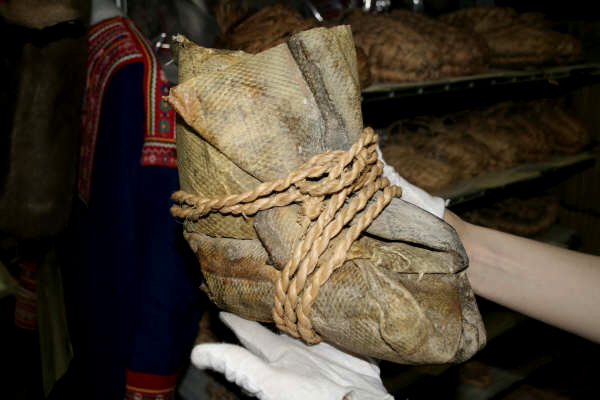
Fish skin clothing has been made in other places besides China
and Siberia. These boots are from Northern Japan and held together
by rope.
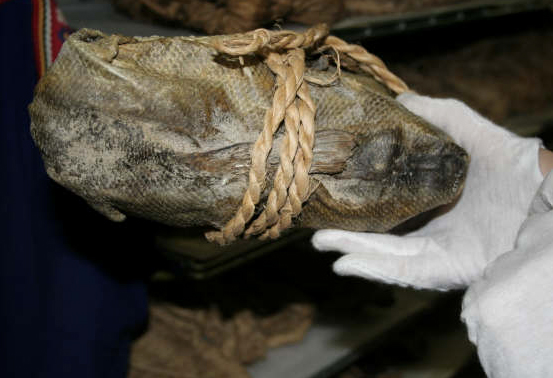
You can see that the shoe maker left one of the fins on. This
pair resides at the Bata Shoe Museum.
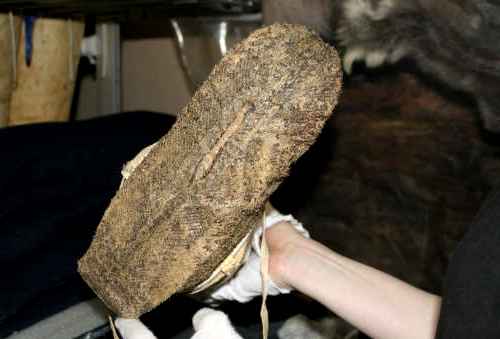
These are from Alaska.
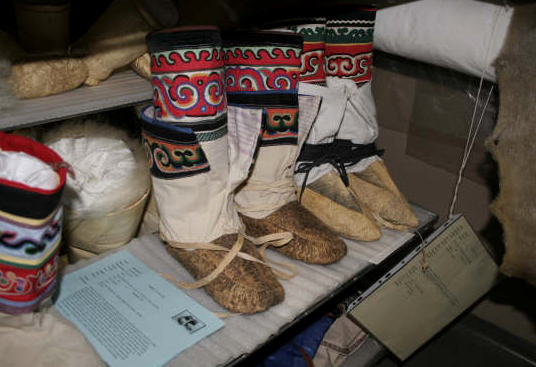
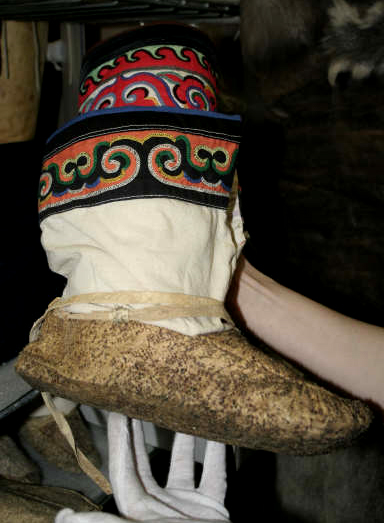
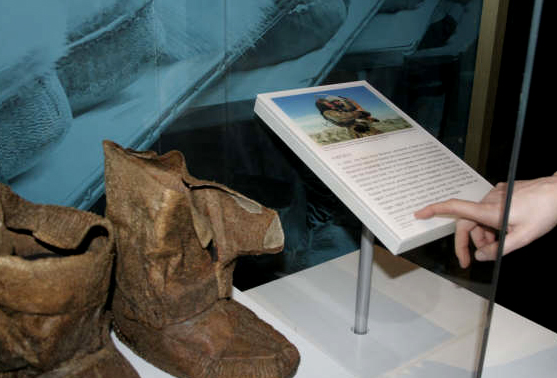
These boots are from Siberia.
<<
top
 The project was made
possible with the support of the
The project was made
possible with the support of the
Department
of Canadian Heritage through the Canadian Culture Online Strategy
The Acrobat Reader
is available free from 